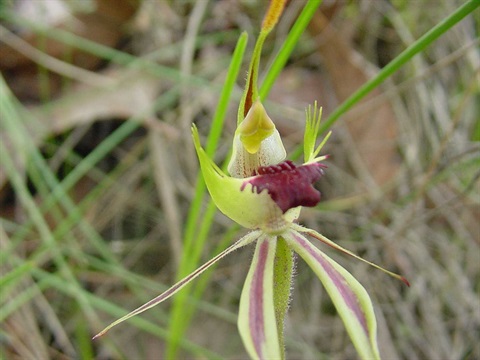
Caladenia parva
Small Spider Orchid
Slender erect perennial growing from round tubers. Stem green, hairy. Dies down in hot weather.
Additional information
- SynonymCaldenia phaeoclavia; Separated from Caladenia dilatata; Arachnorchis parva
- FamilyOrchidaceae
- StoreyLower storey
- Size5-15 cm high
- Plant groupingOrchids
- LeavesSingle hairy lance-shaped leaf 3-10 cm x 5-10 mm with red spots towards the base.
- Flower colourPetals and sepals green with central red stripe
- Flowering timeSeptember to October
- Flowers1-2 flowers; sepals and petals 20-40 mm, tapering to fine yellow clubbed tip, stiff, deflexed; petals narrow, spreading back. Lateral lobes of lip green with erect teeth, mid lobe green at base, becoming white, recurved, toothed maroon tip and 4 crowded rows of maroon warts (calli).
- Bird attractingNo
- Butterfly attractingNo
- Frog habitatNo
- Growing conditionsMoist soil in woodlands and open forest. Semi shade.
- Garden useUse of orchids in gardens is not recommended, unless they already occur naturally, in which case they need to be protected. Removing orchids from the bush usually results in their death and further depletes remaining wild orchid populations.
- Commercially availableNever
- Conservation statusSignificant within the Shire. Known from very few local sites.
- Aboriginal Use Food - tuber
- Related speciesSeparated from C. dilatata. A smaller plant, it differs from Caladenia dilatata by the smaller flowers which has shorter marginal teeth, short yellow clubs on ends of sepals only, sepals drawn back, earlier flowering time & moister habitat. Caladenia phaeoclavia was separated fom C. parva but its differences fall within the variation found in C. parva.
Photo Gallery
Photographer/s: 1, 3 Cathy Powers ©; 2 Owen Gooding ©
Plant Communities